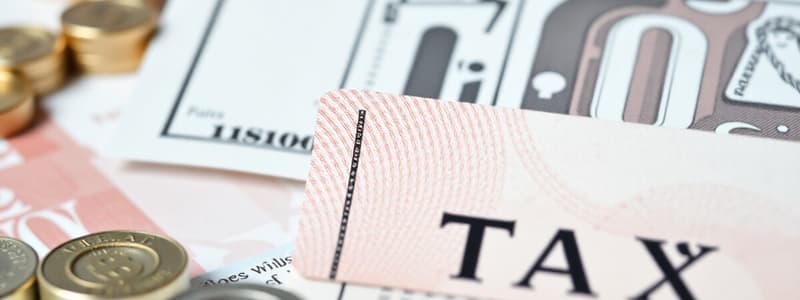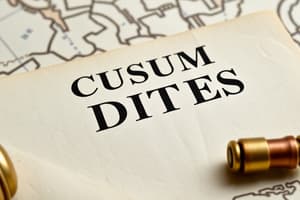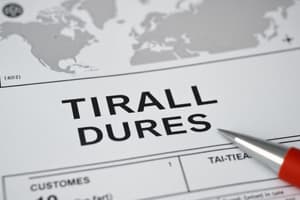Podcast
Questions and Answers
What is the primary purpose of a revenue duty?
What is the primary purpose of a revenue duty?
- To equalize the price of imported and domestic goods.
- To discourage the import of certain goods.
- To raise revenue for the government. (correct)
- To protect domestic industries from foreign competition.
Ad valorem duty is a fixed amount levied on each imported item, regardless of its value.
Ad valorem duty is a fixed amount levied on each imported item, regardless of its value.
False (B)
What is the purpose of an anti-dumping duty?
What is the purpose of an anti-dumping duty?
To prevent the continuous dumping of imported articles into the local market at a price less than those prevailing in its domestic markets.
A tax that includes both specific and ad valorem rates is known as a ______ duty.
A tax that includes both specific and ad valorem rates is known as a ______ duty.
Match the type of customs duty with its description.
Match the type of customs duty with its description.
Which of the following best describes the nature of the power of taxation?
Which of the following best describes the nature of the power of taxation?
The power to tax is limited and cannot be used to protect local industries.
The power to tax is limited and cannot be used to protect local industries.
What is the primary purpose of taxation?
What is the primary purpose of taxation?
Taxes on imports may be increased to protect ______ industries.
Taxes on imports may be increased to protect ______ industries.
Match the purpose of taxation with its description.
Match the purpose of taxation with its description.
Which of the following is NOT a characteristic of taxes?
Which of the following is NOT a characteristic of taxes?
Customs Administrative Orders are issued by the President of the Philippines.
Customs Administrative Orders are issued by the President of the Philippines.
What is the lifeblood doctrine in taxation?
What is the lifeblood doctrine in taxation?
The Doctrine of ______ requires that available administrative remedies be exhausted before seeking judicial relief.
The Doctrine of ______ requires that available administrative remedies be exhausted before seeking judicial relief.
Match the source of customs taxation with its description.
Match the source of customs taxation with its description.
According to the Constitution, where must all revenue or tariff bills originate?
According to the Constitution, where must all revenue or tariff bills originate?
The Senate cannot propose amendments to revenue bills originating in the House of Representatives.
The Senate cannot propose amendments to revenue bills originating in the House of Representatives.
What is the role of the Conference Committee in the enactment of a tariff bill?
What is the role of the Conference Committee in the enactment of a tariff bill?
According to the text provided, importing merchandise is not a ______, but a privilege.
According to the text provided, importing merchandise is not a ______, but a privilege.
Match the step in enacting a Philippine Tariff with its description:
Match the step in enacting a Philippine Tariff with its description:
Which type of customs duty is imposed as a penalty for improperly marked imported articles?
Which type of customs duty is imposed as a penalty for improperly marked imported articles?
Protective duties solely serve the purpose of generating revenue for the government.
Protective duties solely serve the purpose of generating revenue for the government.
What is a countervailing duty designed to offset?
What is a countervailing duty designed to offset?
A safeguard duty can be levied if the volume of imports exceeds a certain ______ or its C.I.F. value falls below a certain price.
A safeguard duty can be levied if the volume of imports exceeds a certain ______ or its C.I.F. value falls below a certain price.
Match the following duties with their primary purpose:
Match the following duties with their primary purpose:
Which doctrine states that courts should generally defer to administrative agencies on matters within their expertise?
Which doctrine states that courts should generally defer to administrative agencies on matters within their expertise?
The Doctrine of Fresh Pursuit only applies to police officers and not to Customs or Coast Guard officers.
The Doctrine of Fresh Pursuit only applies to police officers and not to Customs or Coast Guard officers.
Why is the exhaustion of administrative remedies required before seeking court intervention?
Why is the exhaustion of administrative remedies required before seeking court intervention?
The Constitution grants the President the power to ______ tariff rates, subject to limitations set by Congress.
The Constitution grants the President the power to ______ tariff rates, subject to limitations set by Congress.
Match the power with its effect.
Match the power with its effect.
A country imposes a duty on imported goods from another country that imposes unreasonable restrictions on its products. What kind of duty is this?
A country imposes a duty on imported goods from another country that imposes unreasonable restrictions on its products. What kind of duty is this?
The power to tax is an unlimited power with no restrictions.
The power to tax is an unlimited power with no restrictions.
What is the constitutional basis for customs taxation in the Philippines?
What is the constitutional basis for customs taxation in the Philippines?
The primary source of customs taxation in the Philippines is the ______.
The primary source of customs taxation in the Philippines is the ______.
Match each duty with its description:
Match each duty with its description:
Which of the following is the correct order of steps for a bill to become a law?
Which of the following is the correct order of steps for a bill to become a law?
The primary purpose of the doctrine of primary jurisdiction is to determine a criminal's guilt or innocence.
The primary purpose of the doctrine of primary jurisdiction is to determine a criminal's guilt or innocence.
Customs duties can be very much like what other governmental imposition?
Customs duties can be very much like what other governmental imposition?
The ______ Commission furnish technical information concerning foreign trade.
The ______ Commission furnish technical information concerning foreign trade.
Match each type of tax purpose with the best description:
Match each type of tax purpose with the best description:
Flashcards
Tariff
Tariff
A list of commodities with duties or charges upon each noted.
Customs
Customs
Customary tolls paid by merchants on commodities moving to or from a market.
Specific Duty
Specific Duty
Duties proportional to the number of items imported, based on weight, volume or quantity, regardless of value.
Ad Valorem Duty
Ad Valorem Duty
Signup and view all the flashcards
Mixed or Compound Duty
Mixed or Compound Duty
Signup and view all the flashcards
Revenue Duty
Revenue Duty
Signup and view all the flashcards
Protective Duty
Protective Duty
Signup and view all the flashcards
Anti-dumping Duty
Anti-dumping Duty
Signup and view all the flashcards
Countervailing Duty
Countervailing Duty
Signup and view all the flashcards
Safeguard Duty
Safeguard Duty
Signup and view all the flashcards
Discriminatory Duty
Discriminatory Duty
Signup and view all the flashcards
Marking Duty
Marking Duty
Signup and view all the flashcards
Government Power of Taxation
Government Power of Taxation
Signup and view all the flashcards
Taxation as Inherent Power
Taxation as Inherent Power
Signup and view all the flashcards
Taxation as Legislative Function
Taxation as Legislative Function
Signup and view all the flashcards
Purposes of Taxation
Purposes of Taxation
Signup and view all the flashcards
Non-Revenue Objectives of Taxation
Non-Revenue Objectives of Taxation
Signup and view all the flashcards
Scope of Legislative Taxing Power
Scope of Legislative Taxing Power
Signup and view all the flashcards
Characteristics of Taxes
Characteristics of Taxes
Signup and view all the flashcards
Sources of Customs Taxation
Sources of Customs Taxation
Signup and view all the flashcards
Lifeblood Doctrine
Lifeblood Doctrine
Signup and view all the flashcards
Doctrine of Primary Jurisdiction
Doctrine of Primary Jurisdiction
Signup and view all the flashcards
Doctrine of Fresh or Hot Pursuit
Doctrine of Fresh or Hot Pursuit
Signup and view all the flashcards
Exhaustion of Administrative Remedies
Exhaustion of Administrative Remedies
Signup and view all the flashcards
Constitutional Provisions Affecting Tariff
Constitutional Provisions Affecting Tariff
Signup and view all the flashcards
How Philippine Tariff is Made
How Philippine Tariff is Made
Signup and view all the flashcards
Importing as a Privilege
Importing as a Privilege
Signup and view all the flashcards
Study Notes
- Tariff is a list of commodities with corresponding duties or charges.
- Customs originally denoted customary tolls paid by merchants on commodities.
Customs Duties and Tax
- "Tax" includes all government contributions, including customs duties and imposts.
- "Duties" apply to customs and are nearly synonymous with "imposts."
Classification of Customs Duties
As to Form
- Specific Duty: Levied proportionally to the number of items or units imported, without regard to value.
- Example: P500,000.00 per unit of Automobile.
- Ad Valorem Duty: A tax levied as a percentage of the value of imported articles.
- Example: 5% of the dutiable value of Rhum.
- Mixed or Compound Duty: A tax comprising both specific and ad valorem rates.
- Example: P500,000.00 per unit of Automobile and 30% ad valorem on Dutiable Value of Automobile.
As to Economic Purpose or Effect
- Revenue Duty: Designed to raise revenue for the government, usually minimal or modest and levied on products not produced locally.
- Protective Duty: Intended to protect domestic products from foreign competition by imposing a higher duty on imported commodities.
- Customs duties can serve both revenue-raising and regulatory purposes.
As to Special Purpose
- Anti-dumping Duty: Imposed in addition to the regular duty to prevent the dumping of imported articles at a lower price than in their domestic markets.
- Countervailing Duty: A special duty equal to the amount of subsidy granted, intended to offset the subsidy granted by the exporting country.
- Safeguard Duty: An increased tariff or additional special safeguard duty levied against covered products being imported in increased quantity.
As a Form of Penalty
- Discriminatory Duty: A penalty duty imposed against the articles or product of a country that discriminates against the product of the discriminated country.
- Marking Duty: A penalty duty imposed against imported articles or containers not properly marked with the country of origin, computed at 5% of the dutiable value.
Government Power of Taxation
- Taxation is how a government raises revenue to cover necessary expenses from those who benefit from it.
- Taxation is a mode by which governments make exactions for revenue to support their existence and carry out their legitimate objectives.
- Taxation is the exercise of sovereign power to raise revenue for the expense of the government.
- Taxation is a method of apportioning the cost of government among those who are privileged to enjoy its benefits.
Nature of the Power of Taxation
- The power of taxation is two-fold:
- An inherent power of the state and an attribute of sovereignty.
- Legislative in character, involving the promulgation of rules.
- The power to tax is considered inherent in a sovereign state because it is necessary for the state's existence.
Purposes of Taxation
- Revenue purposes: The basic purpose of taxation is to raise revenues.
- Sumptuary or regulatory purpose: The secondary purpose is to promote the general welfare and to protect the health, safety or morals of inhabitants Non-Revenue (or Sumptuary) Objectives of Taxation
- Taxation can strengthen anemic enterprises.
- Taxes may be increased in periods of prosperity to curb spending and halt inflation and lowered in periods of slump to expand business and ward off depression.
- Taxes on imports may be increased to protect local industries.
- Taxes on imported goods may be used as a bargaining tool by a country by setting tariff rates first at a relatively high level before trade negotiations.
- Taxes can discourage certain businesses (e.g., tobacco and alcohol).
- Taxes can also minimize inequity.
Scope of Legislative Taxing Power
- Amount or rate of tax
- Apportionment of the tax
- Kind of tax
- Method of collection
- Purpose/s of its levy (must be for public purpose)
- Subject to be taxed (must be within jurisdiction)
- Situs of taxation
Characteristics of Taxes
- Forced charge
- Pecuniary burden payable in money
- Levied by the legislature
- Assessed with some reasonable rule of apportionment
- Imposed by the State within its jurisdiction
- Levied for a public purpose
Sources of Customs Taxation
- Primary source: 1987 Constitution.
- Statutory Basis: RA 10863 (An Act Modernizing the Customs and Tariff Administration).
- Administrative enactments: Customs Administrative Order (CAO).
- Jurisprudence: Doctrine of stare decisis.
- Treaties or International Agreements.
Fundamental Doctrines Applicable to Customs and Tariff
- Lifeblood Doctrine: Taxes are essential for the state to finance the needs of the citizenry.
- Doctrine of Primary Jurisdiction: Courts cannot determine a controversy within the jurisdiction of an administrative tribunal.
- Doctrine of Fresh / (Hot) Pursuit: Customs or Coast guard officers can follow or chase a vessel or imported article violating Customs and Tariff laws.
- Doctrine of Exhaustion of Administrative Remedies: All administrative remedies must be exhausted before seeking judicial remedy.
Constitutional Provisions Affecting Tariff
- The President has the power to veto any separate item or items in a tariff bill.
- Congress may authorize the President to fix tariff rates within specific limits.
How the Philippine Tariff is Made
- Tariff bills originate in the House of Representatives and are referred to the Ways and Means Committee.
- Sub-committees hold public hearings.
- The Philippine Tariff Commission provides technical information.
- The Committee discusses and revises the bill.
- The bill is reported out of committee for consideration by the House.
- This process is repeated in the Senate by the Committee on Finance.
- A Conference Committee reconciles the differences between the House and Senate versions of the bill.
- The bill is sent to the President for approval, who may sign it into law.
To Import is Not a Right But a Privilege
- Importing merchandise is not a right but a privilege granted by Congress.
Studying That Suits You
Use AI to generate personalized quizzes and flashcards to suit your learning preferences.





